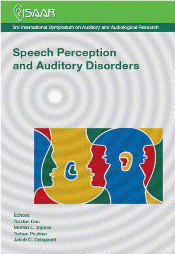Effects of binaural auralization via headphones on the perception of acoustic scenes
Abstract
The auralization of an acoustic scene can be realized with the presentation of binaural signals via headphones. One of the biggest challenges is the individualization of the headphone equalization and the generation of the binaural signals. A promising way is the use of probe microphones for equalization and recording. Very good results in terms of externalization and correct reproduction of the acoustic scene can be reached. However, former investigation indicates consistently that perceived acoustic illusion is much more plausible if the recording and the playback conditions are similar or even the same. Within this contribution we present a fully individualized binaural auralization system via headphones. Binaural recordings of sound sources on different representative positions in two real rooms with distinct different room acoustics are made. These recordings are presented via headphones to test persons. A series of listening tests show the expected influence of an accurate individualization on the correct localization of the synthesized sound source. Furthermore, a strong influence of congruence between the room acoustics of listening and recording room on the perception of the scene was observed. We can show that there is a significant decrease of perceived externalization if the listening rooms and the recording rooms are different.
References
Abou-Elleal, E. R. E. (2003). “Raumakustik – Interaktion visueller und auditiver Wahrnehmungen“, dissertation, RWTH Aachen.
Sass, R., Werner, S., and Siegel, A. (2010). “Comparison of recording methods for measurements of head-related transfer functions“. 26th, VDT Int. Convention, Tonmeistertagung, Leipzig.
Merimaa, J. and Hess, W. (2004). “Training of Listeners for Evaluation of Spatial Attributes of Sound“. Proc. of 117th AES Conv., preprint 6237, San Francisco.
Hammershøi, D. (2009). “Human localization and performance measures”. in Proceedings of ISAAR 2009: Binaural Processing and Spatial Hearing. 2nd International Symposium on Auditory and Audiological Research ISAAR, Denmark. Edited by J.M. Buchholz, T. Dau, J.
Christensen-Dalsgaard, and T. Poulsen. ISBN: 87-990013-2-2. (The Danavox Jubilee Foundation, Copenhagen), pp. 103-111.
Møller, H., Sørensen, M. F., Jensen, C. B., and Hammershøi, D. (1996). “Binaural Technique: Do We Need Individual Recordings?“. J. Audio Eng. Soc, 44(6), pp. 451-469.
Møller, H., F., Hammershøi, D., Jensen, C. B., and Sørensen, M. (1999). “Evaluation of artificial heads in listening tests“. J. Audio Eng. Soc, 47, pp.83- 100.
Hartmann, W. M. and Wittenberg, A. (1996). “On the externalization of sound images“. J. Acoust. Soc. Am., 99(6), pp. 3678-3688.
Additional Files
Published
How to Cite
Issue
Section
License
Authors who publish with this journal agree to the following terms:
a. Authors retain copyright* and grant the journal right of first publication with the work simultaneously licensed under a Creative Commons Attribution License that allows others to share the work with an acknowledgement of the work's authorship and initial publication in this journal.
b. Authors are able to enter into separate, additional contractual arrangements for the non-exclusive distribution of the journal's published version of the work (e.g., post it to an institutional repository or publish it in a book), with an acknowledgement of its initial publication in this journal.
c. Authors are permitted and encouraged to post their work online (e.g., in institutional repositories or on their website) prior to and during the submission process, as it can lead to productive exchanges, as well as earlier and greater citation of published work (See The Effect of Open Access).
*From the 2017 issue onward. The Danavox Jubilee Foundation owns the copyright of all articles published in the 1969-2015 issues. However, authors are still allowed to share the work with an acknowledgement of the work's authorship and initial publication in this journal.


